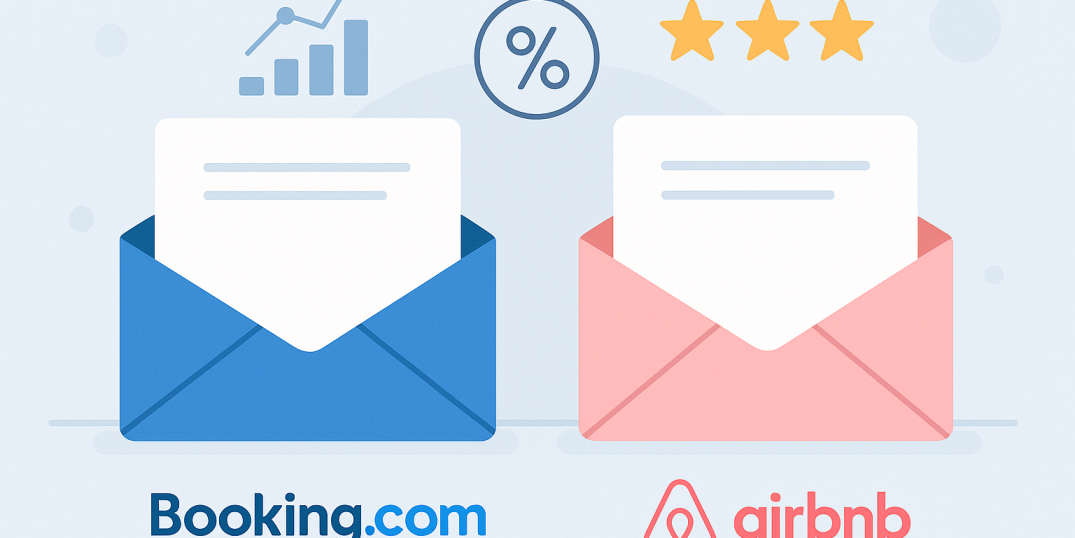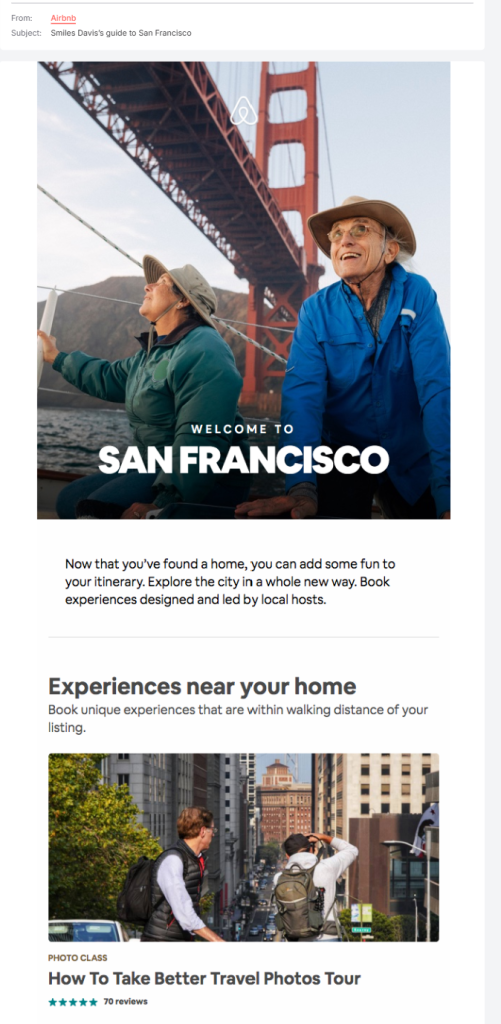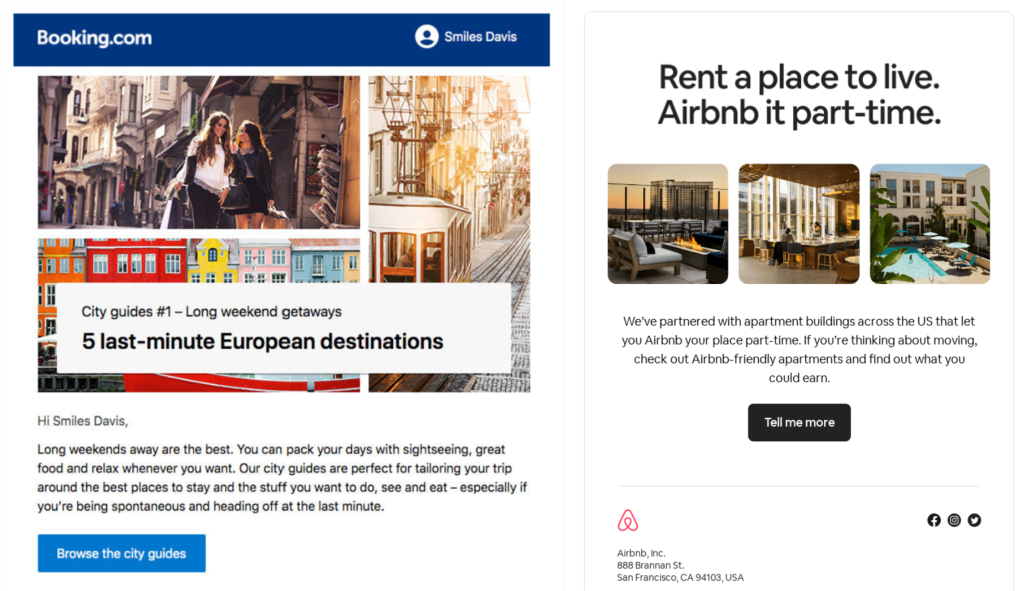- Home
- Friday Column
- Booking.com vs. Airbnb: Who Do ...

Today there’s hardly any traveler who hasn’t used either Booking.com or Airbnb, two of the biggest names in global accommodation. While both companies offer places to live all over the world, their approach to travel email marketing is quite different. Booking.com leans more towards traditional hotels, resorts, and established hospitality providers (while still offering apartments and vacation rentals). Airbnb, on the other hand, has built its brand around private homes and apartments and unique stays hosted by individuals. Booking.com is closer to the traditional hotel industry, while Airbnb focuses on the private sector and on the concept of experiencing living like a local.
Despite both companies’ obvious differences, email marketing has become a key channel for both platforms to engage travelers and promote accommodations and destinations. The way each brand uses email reflects its overall philosophy: fast and transactional for Booking.com vs. softer and more inspirational for Airbnb. In this article, we conduct a detailed analysis of the email marketing approach of both brands, looking closely at how they personalize messages, design their visuals, craft subject lines, and use automation. We’ll compare their strengths and weaknesses side by side and highlight what smaller travel businesses can learn from each.
Audience Segmentation & Personalization
Booking.com relies on hard data from your browsing and booking behavior. How does Booking.com market to you once you’ve searched for a city? By immediately following up with deals in that exact location, sometimes with a warning that there are “only 2 rooms left” at a specific property. Their personalization is focused on conversion. They do so by reminding you of what you looked at, what you nearly booked, and what you might lose if you hesitate. The entire system is built to keep you invested until your reservation is confirmed.
Airbnb, however, personalizes in a very different way. Instead of focusing on scarcity, Airbnb accurately nudges you towards making a decision with sentences like “Homes you might love in Paris.” It leans on your wish lists, your browsing patterns, and your style preferences to make emails that feel more like an inspiration. The marketing strategy of Airbnb is about planting seeds of desire. And they do so by showing users cozy cabins and paradise-like villas. The rest is done by your imagination.

In short: Booking.com vs. Airbnb strategies can be described as urgency vs. aspiration. Booking.com wants you to decide now by applying different urgency cues. Airbnb wants you to dream first and decide later. Both strategies work, but in very different ways.
Design & Visual Storytelling
When it comes to design, Booking.com prefers to keep things minimal. Their emails are built in a way that puts a heavy emphasis on the offer itself, which is emphasized by clean layouts and minimal visuals. If they include an image, it’s usually a small banner or a thumbnail of the destination. Email design mirrors the overall marketing strategy of Booking.com: to promise the deal and a path to get there as quickly as possible.

Airbnb, in contrast, takes the scenic route. Their emails are visually rich, often leading with a big, aspirational photo of a unique property or an evocative landscape. What matters is that the copy supports the imagery, not the other way around. Instead of “Book Now,” you might see “Learn More” or “Explore Homes,” which reinforces the brand’s identity as a curator of experiences rather than just a booking platform. The marketing strategy of Airbnb here is to sell the feeling of travel before selling the booking itself.

Impact on user perception: Booking.com is focused on efficiency and the essence of the offer; Airbnb’s emails feel more like postcards, aiming for the emotional side. Depending on where you are in your travel planning mindset, either one can be exactly what you need.
Subject Lines & CTAs
Booking.com goes straight for urgency (again). Subject lines often look like countdown timers: “Only 3 deals left in Rome this weekend” or “Your hotel in Paris is almost gone.” They also like to personalize by adding your name and destination, which can make an email feel personal but also very on point. Once inside, you’ll see that CTAs follow the same logic: they are bold and action-oriented (“Book Now” or “View Deal”). The goal is to push recipients towards a decision ASAP.
Airbnb, however, likes to play with curiosity and emotion. Their subject lines are designed to spark imagination rather than panic. “Sandy beaches or mountain trails?” indeed feels like an invitation for a great time. Once you open the email, you’ll see that the CTAs are aligned with that softer tone: “Learn More,” “See More Homes,” or “Explore.”
Booking.com vs. Airbnb subject lines compared

Email Types
Booking.com tends to send automated reminders to visitors who started a booking but didn’t finish it, following an industry-standard way to recoup potentially lost reservations. So, if you’ve ever abandoned a booking, you’ll know they won’t let you forget it. Transactional and promotional emails sent by the company include booking confirmations, reservation updates, payment reminders, and personalized deals aligned with a user’s browsing or booking history. The upside of the marketing strategy of Booking.com is that you’re always aware of deals and availability. The downside is overexposure and fatigue that comes with multiple reminders.

Airbnb takes a more diversified and experience-oriented approach. Beyond transactional messages like confirmations and updates, their emails often include personalized city guides, inspirational content, and post-trip storytelling. According to industry insights, Airbnb sends things like personalized city guides based on search history and preferences to inspire users to explore more destinations. These messages feel more like valuable travel content than sales pitches—in line with the marketing strategy of Airbnb, which focuses on retention and meaningful experiences.
| Approach | Pros | Cons |
| Booking.com | High visibility and frequent reminders keep deals top of mind and drive immediate bookings | Risk of inbox fatigue: repetitive content can lower engagement over time |
| Airbnb | Less frequent, content-rich emails feel special and build anticipation and long-term loyalty | Fewer touchpoints mean fewer direct chances to convert in the short term |
Automation & Triggers
With multiple reminders Booking.com sends, the company relies heavily on automation. Their system is designed to react to even minor changes in users’ behavior. Start a booking but don’t finish? Expect an email within hours. Search for Barcelona hotels and close the tab? Tomorrow you’ll get a “Deals in Barcelona” email. On top of that come price-drop alerts and availability warnings. In other words, the whole Booking.com system is geared towards conversions.
Airbnb also uses automation, but the tone of it is different. If you looked at a listing, Airbnb might send a gentle “Still interested?” email with that property listing again, along with a few alternatives. After a trip, they’ll send a thoughtful follow-up asking for reviews or suggesting similar destinations. Automation for them is much more about extending and improving the experience rather than pushing users towards an action.
Which one is better? When comparing the effectiveness of triggers of both companies, Booking.com clearly uses triggers more effectively for conversions. Every reminder, alert, and availability warning is built to push travelers toward completing a booking right away, which makes their automation system a powerful sales engine. Airbnb, on the other hand, uses triggers more effectively for long-term engagement. Their follow-ups and softer reminders are less about immediate sales and more about building trust and extending the relationship beyond a single trip.
So, neither is better or worse—they’re just aiming for different goals.
Localization & Global Reach
Booking.com handles localization in a very functional, transactional way. Their emails are available in multiple languages and priced in local currencies. The company also offers region-specific deals. What it means is that if you’re in Tokyo, you’ll see yen and Japanese copy. If you’re in São Paulo, you’ll see Portuguese and Brazilian offers. This approach is aligned with the marketing strategy of Booking.com, which tries to make the booking process as easy as possible to maximize conversions worldwide.
Airbnb adds an additional cultural layer to localization that goes beyond mere translating. What they do is try to weave local flavor into their campaigns. For example, an email in India might mention festive getaways for Diwali. While an email about French vacation might mention Provence and gourmet dinners with local wines. For Airbnb, localization is more about making the reader feel culturally seen.
Which way to choose? When it comes to localization, there are two ways to go about it for international brands. One is to focus on making everything for your users as convenient as possible by sharing prices in local currency, translating copy to local language, and showing visuals that go in alignment with local cultural expectations. The second way is cultural. This approach is less about convenience and more about the feeling of belonging.
Both approaches have their strengths. The transactional approach might be more efficient with conversions because it keeps everything straightforward. Cultural localization, on the other hand, is more emotional and helps readers recognize the context better and feel less alienated. They both “speak local,” just in very different ways.
Strengths & Weaknesses Side by Side
| Aspect | Booking.com Pros | Booking.com Cons | Airbnb Pros | Airbnb Cons |
| Segmentation & personalization | ✅ Highly data-driven | ⚠️ Can feel pushy and repetitive | ✅ Suggestions based on browsing | ⚠️ Less aggressive follow-up |
| ✅ Reminds users of searches and abandoned bookings | ⚠️ Urgency may cause pressure fatigue | ✅ Inspires. exploration | ⚠️ May miss quick-win bookings | |
| ✅ Strong conversion focus | ✅ Personalization feels gentle | |||
| Design & storytelling | ✅ Clean, minimal, deal-focused layouts | ⚠️ Functional but bland | ✅ Image-rich, aspirational design | ⚠️ Heavier design focus may slow direct decision-making |
| ✅ CTAs stand out clearly | ⚠️ Lacks emotional appeal | ✅ Sells the lifestyle, not just the booking | ||
| Subject lines & CTAs | ✅ Urgency-driven subject lines | ⚠️ Can create stress or FOMO fatigue | ✅ Emotional, curiosity-driven subject lines | ⚠️ Less urgency, weaker at driving immediate clicks |
| ✅ Strong CTAs | ✅ Softer CTAs | |||
| Email types | ✅ Frequent reminders keep deals top of mind | ⚠️ High volume risks list fatigue and unsubscribes | ✅ Less frequent, content-rich emails feel special when received | ⚠️ Fewer touchpoints reduce opportunities for direct conversions |
| ✅ Wide variety of transactional + promo emails | ||||
| Automation & triggers | ✅Sophisticated system | ⚠️ Overautomation can feel relentless | ✅ Gentle nudges, thoughtful post-trip emails | ⚠️ Less aggressive automation means slower conversion cycles |
| ✅ Instant responses to behavior (abandoned cart, price drops, etc.) | ✅ Builds trust and continuity | |||
| Localization & global reach | ✅ Multilingual support in 40+ languages | ⚠️ Focuses on transactional convenience, not cultural depth | ✅ Localized storytelling highlights hosts, traditions, and experiences | ⚠️ Less emphasis on transactional details like pricing convenience |
| ✅ Local currency and region-specific deals | ✅ Feels culturally relevant |
Key Takeaways for Travel Marketers
What can small/mid-sized travel businesses learn from each approach?
Booking.com shows how effective it can be to stay close to your customer’s intent—if someone searched for Rome, remind them about Rome. It’s simple, but it works. How does Airbnb market? It proves that not every email has to scream “book now.” Sometimes a beautiful image and a story about a unique place can be just as powerful. Together, they remind us that conversion and inspiration are two sides of the same coin.
How to balance urgency-driven conversion tactics with storytelling?
There are moments when people need that little push—like a price alert or a “last room left” message. But there are also moments when they just want to dream, and that’s when storytelling helps. If you only ever push urgency, you risk wearing people out. If you only tell stories, you might never close a sale. The magic happens when the two complement each other. And the good news is that you don’t have to build everything from scratch—free HTML email templates can give you a head start in balancing practical deal-driven layouts with more visual and story-driven campaigns.
Which tactic to adopt?
Honestly, neither approach is better on its own. It comes down to what you want to achieve. If your main goal is to fill seats or rooms fast, Booking.com’s urgency is a masterclass. If you’re building a brand that people want to come back to again and again, Airbnb’s softer touch might feel closer to home. And maybe the real lesson is not choosing one over the other but borrowing a little from both.
To Sum Up: Who Wins?
So, who really does travel email marketing better in the Booking.com vs. Airbnb clash? The answer depends on what you value most. Booking.com is a master of conversions, and if your goal is pure efficiency, they set the standard. Airbnb, however, wins on another front. Its emails feel inspirational and human. They invite you to dream and to see travel as an experience.
Neither approach is inherently superior; they are simply different expressions of brand philosophy. One focuses on speed and volume, the other on emotion and belonging. And that’s the real takeaway for marketers: there is no single right way. Some audiences respond to urgency, others to storytelling. The best results often come from blending both—a reminder when someone is ready to book and an invitation to dream when they are not.



